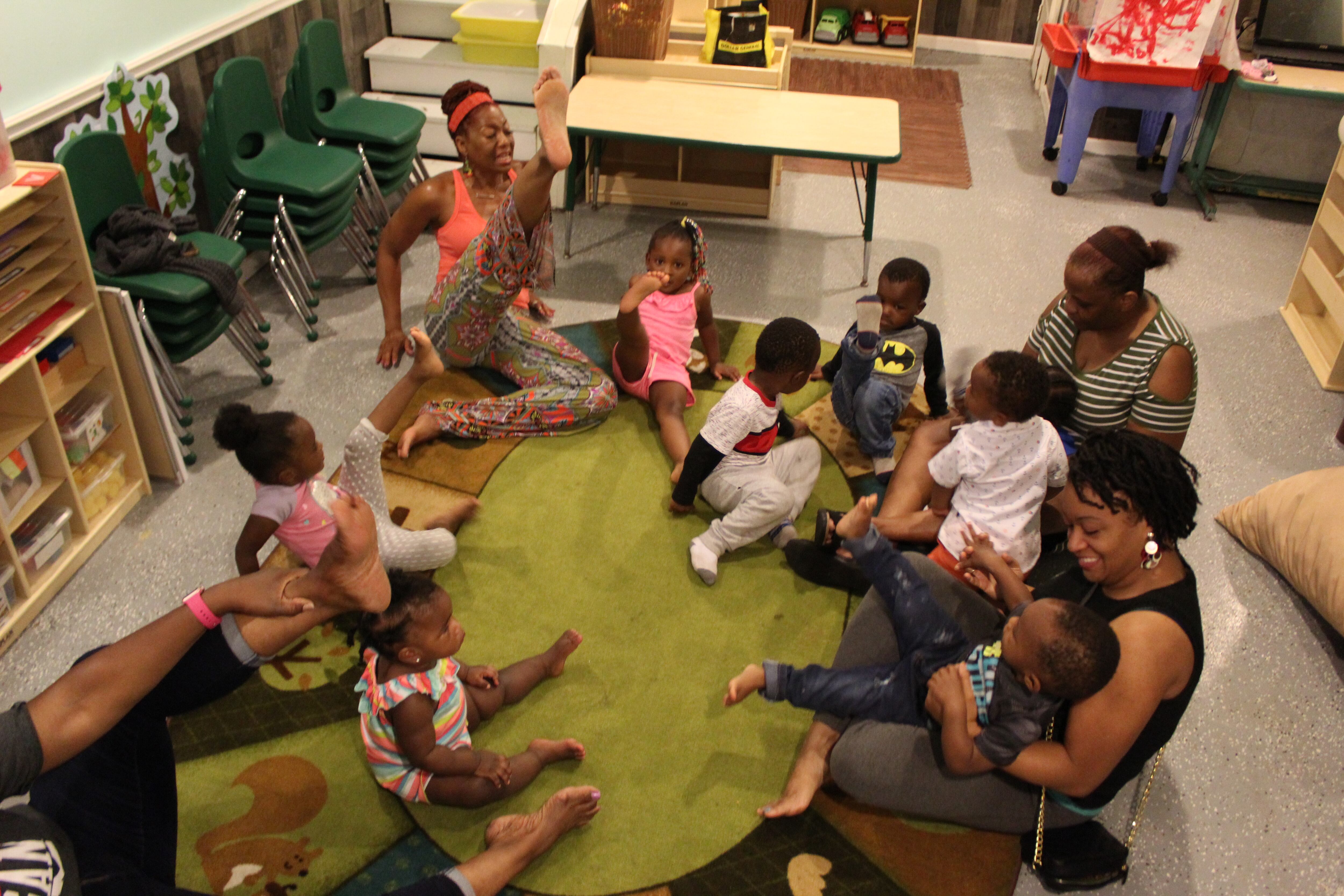In May, the nonprofit journalism site MuckRock and several Michigan newsrooms published their initial findings on Michigan’s child care crisis, including the high number of facility closures during the pandemic.
We invited Michiganders to tell us about their experiences on both sides of the child care industry — as a parent trying to find care for their child or as a provider trying to stay in business.
We received more than 170 responses, many of which included detailed policy proposals. Here are eight of those ideas, along with accompanying analysis from experts, lawmakers and state agencies about their potential feasibility:
Allow more families to receive state child care subsidies
Christie Mahl’s day care, Acorn Child Development Center in Lapeer, has a waiting list of more than 100 children. Those long lists are not uncommon in Michigan, particularly with centers like hers, which has a 5-star rating from Great Start to Quality, Michigan’s rating and improvement system for day cares. Hers is the only 5-star center in 90,000-person Lapeer County.
At $46 a day, Mahl’s day care is markedly cheaper than comparable centers in urban areas, which can charge up to $70. Some parents don’t pay anything if their income level is low enough to qualify for a state child care subsidy. But many of her parents make too much to qualify. These “borderline” families pay for child care out of necessity, even if it takes a bite out of their annual budget.
“Imagine making $50,000 and having to pay $1,000 a month,” Mahl said. “It’s a hardship.”
Temporarily increasing the subsidy income brackets was one of the first pandemic relief measures deployed by the state, which pushed the subsidy qualification from 150% to 185% of Michigan’s poverty line.
But the success of that effort has been mixed, according to researchers from the University of Michigan. They have found fewer applications for the subsidy despite more families becoming eligible — likely because of a lack of available spots at day cares statewide.
“There were over 100,000 more families that became eligible for the subsidy as a result of increased funding for the program, but we really didn’t see pickup rates improve to a great extent,” said Karen Kling, strategic projects manager with University of Michigan’s Poverty Solutions program. “They were pushing families toward spots that didn’t exist.”
Mahl also suggested implementing a new tier of center for 18-child facilities. Currently the state licenses six- and 12-child facilities and much larger centers for dozens of children, but nothing in between.
Provide options for flexible at-work child care
Fifteen months into parenthood, Hillary Rose is already on her 10th nanny. When her child was born, the two day cares in her area were full. Nannies and babysitters have cost her about $1,200 a month, she estimates, but she pays it because it gives her precious hours of breathing room to focus at her job.
“I do feel like it’s kind of a requirement if I want to continue to work,” said Rose, who lives in Carleton.
Rose teaches U.S. history at a virtual school, which she can do remotely, but not with a toddler on her lap. The nannying solution isn’t perfect either: She’s often searching through Care.com, a child care networking site, for affordable babysitters. She said the more qualified sitters can charge $25 an hour, which is more than she makes teaching. More realistic options for her have been high school graduates without qualifications, but who occasionally fail to show when she needs them most.
Recently, Rose has toyed with the idea of opening a drop-in care center for remote working parents. She describes it as a kind of child care WeWork, where parents who just need a few hours of time at a desk each day could easily switch between work and care. She thinks parents need more flexible options, given the popularity of working from home. It’s an idea born from the immense challenge of balancing a full-time job and raising a kid.
“I really wasn’t expecting it to be this difficult,” Rose said.
The principal roadblock to Rose’s idea is Michigan’s long history of strict zoning regulations for child care facilities. Legislation passed in June loosened some of those zoning requirements, opening the door for child care facilities in commercial-use zones.
Factor outstanding debts into child care subsidy qualification
Monica Rosen feels like she made all the right choices: She went to college, got a good job at the University of Michigan, bought a house and had a family. But lately, she feels like she’s being crushed, she said, as she stares down the prospect of paying nearly $19,000 a year for a slot at the university’s Towsley Children’s House day care.
“I don’t qualify for the grants they offer, because you have to be in poverty, but they don’t count my student loans and other financial considerations when calculating who gets grant money,” said Rosen, who lives in Mount Pleasant. “I feel like once I pay for preschool, I am now in poverty.”
Red tape around the subsidies often hindered their use, said William Lopez, assistant professor at the University of Michigan’s School of Public Health. Qualifying requires parents to prove that they are working or studying. Parents also must regularly reapply, as well as have their taxes in order — all of which contributes “to a very low proportion of children who are eligible receiving vouchers,” Lopez’s team found, according to forthcoming research they shared.
Provide affordable health care for child care workers
In 2020, Karen Lumsden’s child care center, Children’s Place Montessori in Troy, ate a $110,000 loss. Some of it was recouped by $70,000 in one-time grants from the state, but she’s only just recovering from the pandemic shutdowns. Her Montessori center, which is licensed for 70 kids, is still below its capacity mark by 20 children.
Staffing challenges means she can’t open a third room and be fully operational.
“Had the grant money not come, I would be totally screwed,” Lumsden said. “It was a godsend.”
What would further help Lumsden, she said, is an affordable health care option for her staff. Of eight employees, seven are on their spouses’ health care plans and the eighth pays heavily out of pocket for health care via the Affordable Care Act.
Lumsden said day cares that offer health care have an easier time hiring. But she can’t offer it now because her business would dip into debt.
“That’s just the reality,” Lumsden said. “They’re going into a business that can’t sustain them. If they had an insurance option for child care workers, whoa. Insurance would be such a boon.”
Companies could subsidize tuition to attract workers
On average, Tea Shong’s teachers stay on staff for just 18 months. Some find child care isn’t for them, while others love the work but decide to pursue higher pay in K-12 school systems, which offer benefits as well.
“Some of our best employees move on to the K-12 system,” said Shong, of Lenawee.
Shong thinks the state does enough to support parents and providers. Her teachers should make more, but she thinks that, in today’s economy, employers looking to attract workers should be footing more of the bill — offering child care pay as a benefit.
If that were more common, Shong would be able to charge more knowing that employers are splitting the bill with parents, and then be able to bump wages for her teachers. As it stands, her teachers make $12 to $14 an hour.
“I believe more workplaces should offer child care support, like they offer insurance,” Shong said. “These teachers do some of the most important work, and their pay does not reflect it.”
The Michigan Department of Licensing and Regulatory Affairs, which regulates and investigates complaints about child care facilities, has found more than 9,000 child care staff vacancies across the state and is now letting some facilities apply for rule exemptions to hire younger staff who are finishing required coursework and are awaiting final certifications. A survey the agency sent out this spring found that staffing turnover affected a majority of facilities and ranked as the No. 1 factor affecting the number of available child care openings.
And the No. 1 reason why Michigan child care facilities said they couldn’t attract new staff? Low wages and nonexistent benefits.
Help from the private sector is one of the flagship ideas implemented by the Whitmer administration. The program, known as Tri-Share, splits child-care costs among an employer, employee and the state. But it only serves families that make between 200% and 325% of the federal poverty line — $34,840 to $60,970 for a single mother, for example — a population that isn’t served by the subsidy.
In a statement, Gov. Gretchen Whitmer’s office said it is proud of the work of Michigan Tri-Share but, as of now, the program has enrolled just 57 children since its inception more than a year ago in June 2021.
Tri-Share reports cite a number of reasons for the program’s low uptake, including the number of child care deserts in Michigan.
Build a web portal for parents and providers
To keep centers profitable, they need full enrollment. That’s why for years, Louise Stoney has argued that tech could provide answers for child care facilities across the country.
With an app, centers could give real-time enrollment numbers and post to a marketplace for anxious parents shopping for care. Instead of calling every center in their ZIP code, they could quickly see when and where openings come online, saving parents time and keeping providers’ classrooms full.
“We need to create some scale and stability so that they’re not just out there trying to do everything by themselves,” said Stoney, an independent consultant specializing in early care and education. “Technology is a big part of that.”
In Michigan, no such digital platform exists. The closest alternative is Care.com, a website that helps parents shop for caregivers.
Better software would also relieve child care providers of another headache: the amount of paperwork required by state regulators, such as attendance logs. And it would provide better child care data to the state, which currently relies on out-of-date and inaccurate licensing numbers.
Stoney said that real-time systems like these have already been deployed. Pilot programs exist in Colorado, where counties have invested in a platform called BridgeCare. Another platform, LegUp, offers similar real-time data sharing and operates in Wisconsin and several other states.
Create universal pre-K in Michigan
For state Rep. Yousef Rabhi of Ann Arbor, the problem is clear: Child care isn’t funded in the same way as the state’s K-12 public school system.
Rabhi’s solution would be to fold Michigan’s nearly 8,000 child care facilities into a statewide universal pre-kindergarten system. Rabhi thinks universal pre-K would stabilize the child care workforce by adding benefits, such as health care.
It would also remove the cost barrier for hundreds of thousands of Michigan parents with a free public system. Universal pre-K has already been implemented in Florida, Vermont, Oklahoma, and the District of Columbia, as well as in more than 30 cities across the country.
“This isn’t a far-fetched idea. It’s not like we’re doing something completely brand new,” Rabhi said. “It’s just that we arbitrarily cut the system off at kindergarten.”
In 2019, Whitmer said she wanted to achieve such a system by the end of her first term. And a bipartisan mood around child-care reform has put universal pre-K on the table, Rabhi said, even if the price tag would be significant.
Using federal estimates, the annual market cost of a universal pre-K system for Michigan’s 3- and 4-year-olds comes out to $972 million per year — an estimate built using a $6,600 per capita figure used to vet President Biden’s American Families Plan. That’s just for tuition, however.
Modeling experts at the Children’s Funding Project, a policy group that provides cost estimates to government bodies, said that a “true cost” — one that includes infrastructure investments and a living wage for workers — would likely double that estimate. “It would range somewhere from $14,000 or $15,000 to $18,000 to $20,000 for a preschooler,” said Kate Ritter, an adviser with the organization who specializes in finance and cost modeling. Ritter’s estimate puts the cost of universal pre-K closer to $2 billion.
The Children’s Funding Project has actually begun work modeling revenue options for universal pre-K in Michigan. In the past, the group has provided states with memos identifying how states can find cash to pay for broader child care programs, such as by raising corporate income taxes.
Reinvest in in-home centers
For state Rep. Jack O’Malley of Traverse City, state involvement in child care has historically been the problem, rather than the solution. Before a recent changing of the guard at Michigan’s state licensing agency, small in-home providers reported being harangued by licensing consultants.
These consultants would often write up small, mom-and-pop day cares for minor violations, and fed-up providers would call it quits, as O’Malley describes it.
Simply put, safety concerns and a preoccupation with academics have pushed the state to overregulate and ask childcare providers for too much documentation, O’Malley said.
“When you are requiring that employees have certain levels of degrees — do we need that?” O’Malley said. “Are our center-based day cares becoming pre-kindergarten kindergarten? Are we now having them reading the classics?”
Financially, the argument for more in-home centers goes both ways.
In-home centers are more geographically and financially accessible, sometimes charging half as much as larger centers. But they can quickly become losing business propositions for their owners, who need a critical mass of children to be profitable.
A survey sent out to child care providers this spring by the Michigan Department of Licensing and Regulatory Affairs found that in-home facilities reported loss of income as the No. 2 impact of staffing shortages, just behind the inability to enroll more children. And in-home providers overwhelmingly supported the idea of reducing staff-to-child ratios, compared with larger child care centers, the survey found.
In June, O’Malley proposed, and helped pass, legislation increasing the ratio of children in-home centers could serve. One employee can now care for up to seven kids, up from six, and a two-employee center can now care for up to 14 kids, up from 12. (Some states, like Washington, allow one employee to care for up to 10 preschoolers, aged 30 months to 5 years old.)
O’Malley said the bill has been met with “hoorays and cheers.”
But child care experts worry that such hands-off policies won’t fix much — and could endanger children. Linda Smith, executive director of the Bipartisan Policy Center’s Early Childhood Initiative, a think tank in Washington, described the legislation as “looking for a quick fix.”
“The answer is not just put a couple more kids in and that’ll fix anything,” Smith said. “It’ll only make it worse, because it’ll drive more staff out. We should not go down the road where we just relax the regs.”
Reporter Luca Powell did the reporting for this project for Muckrock, a nonprofit investigative journalism newsroom.






